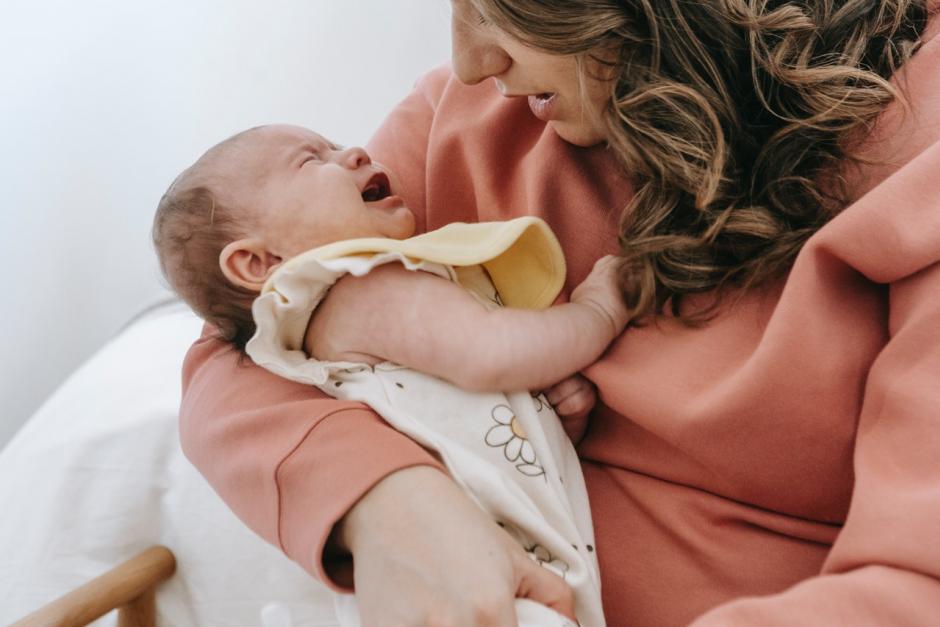It’s never pleasant, putting your baby to sleep in a cot or Moses basket then hearing on the baby monitor them wake up or start to cry. Controlled crying. Does it work? Is it right for your baby? If you’re considering using it to reduce any sleep problems with your little one, you likely have questions. For some people, it’s a godsend, for others it’s controversial.
To help, here we explain what controlled crying is, how it works, if it works, and how to decide if it’s something you want to try.
What is controlled crying?
Controlled crying – also called controlled comforting or the spaced soothing approach – is a sleep training method. It trains your baby into soothing themselves and falling asleep on their own.
The key step of the approach is to let your baby cry by themselves, without you soothing them, for set periods. The idea is that during these set periods, they learn to calm themselves. And over time, they learn to put themselves to sleep.
How does controlled crying work?
The controlled crying approach is based on the following steps:
1. Establish a routine before bedtime: Create an evening routine that you stick to that shows your baby that bedtime is coming. This could involve taking a bath, dressing in pyjamas, having a feed, and reading a book before getting into bed.
2. Put your baby down to sleep: Use safe sleep habits. Place your baby down on their back in a cot with a firm mattress. Say good night, then leave the room whilst they are still awake.
3. Allow your baby to cry for a short time: Don’t enter the room immediately if your baby starts to cry. Let them cry for a time before entering and comforting them. Try to comfort them in their bed and try not to pick them up. Commonly, the first recommended time is two to three minutes. Leave the room again when your baby is soothed.
4. Wait longer if your baby cries again: If your baby cries once more, again don’t enter the room right away. Wait two minutes longer than the previous time before entering and comforting them. If you waited three minutes the first time, wait five minutes the second time.
5. Repeat the process with longer intervals each time: If your baby cries again, add another two minutes to the time you wait before entering the room to comfort them. If you waited three minutes the first time, wait five minutes the second time, seven minutes the third time, and nine minutes the fourth time. It’s not recommended to increase this time to more than ten minutes, however.
6. Continue to use controlled crying consistently: Keep the process up until your baby falls asleep. Stick to the process each night (consistency is the key with controlled crying), and over time your baby should learn to self-soothe and to fall asleep by themselves.
At what age can parents introduce controlled crying?
The most common advice is to introduce controlled crying once your baby is six months old. Baby’s typically develop more stable sleep patterns after six months and will begin to recognise the cues that bedtime is coming.
You can introduce controlled crying later, at any time when your baby or toddler can’t put themselves to sleep and cries when you leave them. However, the later you leave it the longer it can take for your child to break previous sleep habits and adapt to controlled crying.
Is controlled crying just for bedtime at night?
No. Whilst controlled crying is most often described when putting a child to bed at night, it can also be used for nap times. You can use controlled crying on every occasion you put your baby down to sleep. For nap times, make sure you develop a pre-sleep routine too.
Is controlled crying different from crying it out?
Yes. Controlled crying and crying it out are two different and separate approaches.
There are different forms of crying it out, but most involve leaving a baby to cry until they fall asleep, with little to no comfort from a parent. Controlled crying does involve leaving your child to cry by themselves, but only for short, controlled periods. It also involves comforting your child.
Does controlled crying work?
There is scientific evidence that controlled crying works for some children. Research has shown it can help reduce sleep problems in around one in four babies and toddlers. The research found no adverse effects after five years of parents using controlled crying too.
It also found that controlled crying works for some children and not for others. Some parents worry that controlling crying may affect the emotional development of their child, but thankfully the research didn’t find any problems with this.
Why is controlled crying controversial?
When a baby is crying, they’re most likely upset, stressed and/or scared. There’s a worry that if you leave a baby crying without giving them comfort, their stress and fear will increase to traumatic levels. This can be bad for a baby both emotionally and physically. There’s also a worry that if you often leave a traumatised baby crying for long periods, you can harm their development. That they’ll develop emotional and developmental problems, including attachment issues, that can last throughout childhood and into later life.
Controlled crying doesn’t involve leaving your baby or toddler to cry for long periods, however. The short periods where you leave your little one to cry, shouldn’t be long enough for them to cry traumatically. Research conducted on controlled crying didn’t find any long-term problems associated with it.
If your do hear your baby’s cries changing in tone to something more desperate, then don’t wait the full time. Enter the room and comfort them. It’s better to listen to your baby’s cries rather than watching the clock strictly.
Is controlled crying right for me?
Whether or not controlled crying is right for you, will depend on you, your partner, and your baby.
Controlled crying can be tough on parents. When your baby cries, your first reaction is likely to comfort them. But with controlled crying, you have to ignore this instinct, at least for a time. Some parents find this too stressful and emotionally draining to manage, particularly night-after-night. The research that has been conducted on controlled crying has shown it works for some children, but not for all. If you want to give controlled crying a try, you can set a trial period – say two weeks – and see if works.
Controlled crying isn’t for everyone. But if done sensibly and consistently, it can reduce sleep problems in some children without causing any emotional or developmental harm.
Sources:
https://www.healthline.com/health/baby/controlled-crying#how-to-do-it
https://www.goodto.com/family/babies/controlled-crying-289739



Leave a Comment: